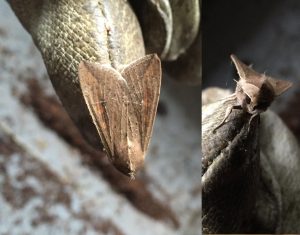
Wax moths and mice are common pests for bees and beekeepers. We have had more experience dealing with them lately for some reason. Here are some of our experiences with these two pesky pests.
Mice enjoy building nests in the depths of boxes, especially when they are stored away. Sometimes they can get away with living at the bottom of a hive while the bees keep themselves warm and eat honey, pollen patties, and candy boards at the top of the hive. To prevent mice infestation we always put on a mouse guard or entrance reducer that eliminate the chance of having mice enter our equipment that is out in the field. In fact, we typically use this device year round because limiting the opening helps the hive defend against hive beetles as well.

To prevent mice from getting into stored boxes we always store them on flat surfaces and make sure that they are fully covered. This prevents the mice from entering and damaging the boxes and frames.
When mice get into unguarded boxes they not only make a home for themselves, but they defecate all over everything. If there are frames of drawn comb, they will chew on the frames and eat the foundation and its contents. This destroys the work of the beekeeper and the bees. Urine soaked frames and boxes are virtually unusable by bees and beekeepers.
All of our honey supers are kept in our garage in the off season. Besides honey supers we do keep some drawn comb deeps that we store for future use from time to time. Also we have a few boxes of used frames that are waiting to have their wax melted by our wax melter and the frames cleaned and reused.

All of these things seem to draw a wax moth in. Especially in our garage. the drawn comb seems to be especially tantalizing to the wax moths. Despite the fact that we use moth repellant on our supers the moths tend to find us.. It must be the old comb that we like to melt down in our wax melter that draws them in. In the future we will be storing less of this comb.
Wax moths can only reproduce inside a bee hive, and the only way they can get on the wax comb is because the hive is weak or the beekeeper let the bees get to the precious wax.

This year we took over the management of the honey bees at a local vegetable farm. We started by cleaning up the equipment, which was left virtually unprotected by the previous beekeeper. This left us with less than half of the equipment in usable condition. Wax moths and mice damage was very severe. The pictures you see are from this experience. Hopefully protecting comb and equipment will be everyone’s priority.
If our cleanup and management efforts are successful, the good news is that we think this new location will produce decent amounts of honey for us and the landlord. Hopefully things will go as planned!!!